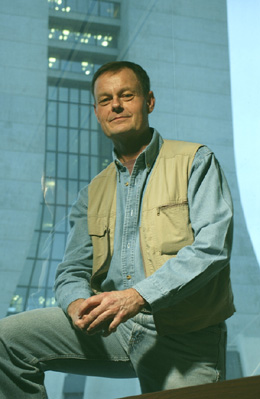 |
|
Peak Experience
by Mike Perricone Biking, downhill skiing and mountain climbing,including an unsuccessful solo attempt on the Matterhorn —it all sounds like the description of a serious risk-taker. This daredevil in question, new Beams Division head Roger Dixon, learned the lesson of a lifetime in taking risks seriously,through an over-the-edge experience as a high school ski racer in Breckenridge,Colorado.
“My brother and I were on the racing team,and there was another set of brothers on the team as well,” Dixon recalled.“They were better racers, but I was always very competitive and aggressive —too much so,it turned out. One day I put myself in a situation I knew I couldn ’t handle.I mis-timed a pre-jump,and I wound up in a full-body cast.So I learned to give lessons instead of becoming a professional ski racer.” He also spent enough time off the mountain to become a physicist.In 1977, while working with Maury Tigner as a postdoc in particle physics at Cornell, Dixon moved on to Fermilab.Almost immediately,he took over as Switchyard Group Leader,responsible for extracting beam from the Main Ring for the experimental areas. “Talk about taking on a mountain,” Dixon said wryly.“In retrospect, I probably wasn’t ready for that assignment.” But he made the climb. It was just the first, followed by terms as deputy head of the Tevatron II Project, head of the DZero Construction Project, five years as head of the Research Division (1992-1997), and most recently project manager for the Cryogenic Dark Matter Search. Dixon took over as head of Beams on Jan.15,2003, succeeding interim head Steve Holmes, who returned to the Directorate as Associate Director for Accelerators. Over the past year, a lab-wide push has brought the Tevatron to record levels of luminosity, but that’s just the start of this next climb. “This is a big mountain, a risky mountain,” Dixon said,describing himself as a “catalyst ”in meeting the new challenge. “What I know is that the division is filled with extremely talented people. If I’m successful,what will happen is that some very clever people over here will execute some very clever ideas, and they will make the collider beam and the beams for experiments like NuMI and MiniBooNE work very well. We ’ll meet our goals and I hope go beyond them, and after a few years there will be some real heroes, and nobody will have much even noticed that I was here. If I ’m successful.” Fermilab director Michael Witherell emphasized three critical roles for Beams in Run II, and in the laboratory ’s future: 1) carrying out the 2003 plan for the collider that was presented to the DOE review committee in October,2002; 2) planning the following years of work on the collider program; 3) providing more protons for the collider program, and for MiniBooNE and NuMI in the neutrino program. Witherell also emphasized Dixon’s role, despite the deferential stance. “Part of what Roger brings is a very modest approach in describing his own role, and that’s actually part of what makes him effective,” Witherell said.“He has a good picture of how to marshal a large effort, and how to get people to work together effectively. His variety of management responsibilities, from managing the Research Division to managing large construction projects, gives him experience in seeing what will work best in a given situation. Roger also knows the rest of the laboratory very well, which is helpful because we are calling on people from all over the laboratory to support this effort. We are approaching the accelerator work in a project-like style, a very organized way of bringing people and resources to bear in the most effective way. Mike Church is the project leader in that sense,but having Roger as division head will bring more experience in how to carry off very large,and difficult,technical projects.” For Dixon, it all comes back to the mountain, and how the team functions in making the attempt. “The way you build a team is serious business, especially for a dangerous mountain,” he said. “You’re going to be depending on those other people to essentially save you, if it’s necessary. You have to have as many people as you can who are able to take the lead. You need talented people who are going to share the work. For a very big mountain, there will also be a group of people who basically supply support. As you climb the mountain, you establish a series of camps, and you have to supply those camps, which means a lot of people have to carry loads back and forth. Then eventually your strongest climbers will make their way to the highest camp,and make an attempt on the summit.” That view from the top is what it’s all about.
ON THE WEB:
|
